C2.7 - Kingdom Animalia
Overview
- zoology: study of animals
- Multicellular, no walls, all heterotrophs
- Able to:
- ingest food
- circulate oxygen throughout body
- dispose of undigested food and metabolic wastes
- Each species has…
- bauplan / body plan: animal blueprint or master plan
- incl. structural details and features like
- type of symmetry
- presence of body cavity
- embryological devel.
- segmentation
- presence of head
- # of limbs
- mobility
- presence of backbone
- >1 mil. animals in 35 phyla
- Levels of Organization (4 Types of Tissues)
What are Animals?
- Animals are eukaryotic
- Animal cells lack cell walls
- Animals are multicellular
- Animals are heterotrophs that ingest food
- Animals are motile at some point in their life cycle
- Animals form a blastula during embryological development
- blastula: hollow ball of cells
Major Groups of Animals
- invertebrates: animals w/ no backbone (i.e. earthworm)
- vertebrates: animals that have notochord and backbone at some point in life cycle
- notochord: skeletal rod of connective tissue running beneath spinal nerve chord
Body or Germ Layers
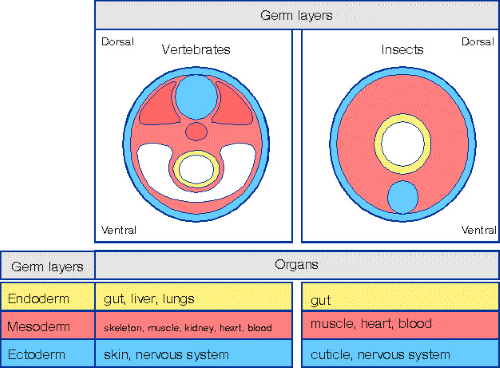
- body or germ layers: cells in embryo that give rise to specific tissues in adult
- 3 Types — def. begins w/ gives rise to
- ectoderm: skin and nervous system
- endoderm: lining of gut
- mesoderm: organs, muscles
- lacking in less developed animals
Body Cavities
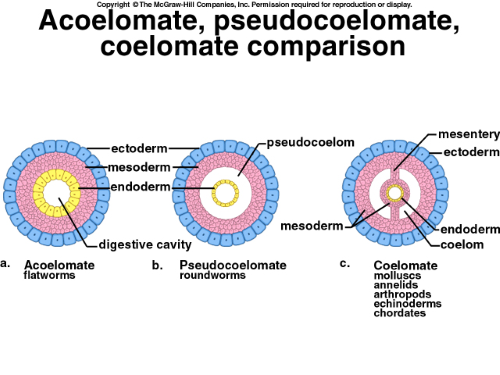
- coelom: fluid-filled space between body wall and gut, derived from mesoderm
- animals that have it: humans
- pseudocoelom: cavity that lacks true mesoderm lining of true coelom
- animals that have it: Nematodes (roundworms)
Embryological Development
- begin life as zygote when sperm fertilize egg
- blastula forms eventually
- infolding of cells occurs at particular spot in ball
- infolding eventually pushes all the way through hollow ball forming tube that connects both ends
- tube develops into digestive tract
- blastopore: first opening in digestive tract during devel.
- protostome: animal whose blastopore develops into a mouth
- protos = “first”, stoma = “mouth”
- deuterostome: animal whose blastopore develops into an anus
- protostome: animal whose blastopore develops into a mouth
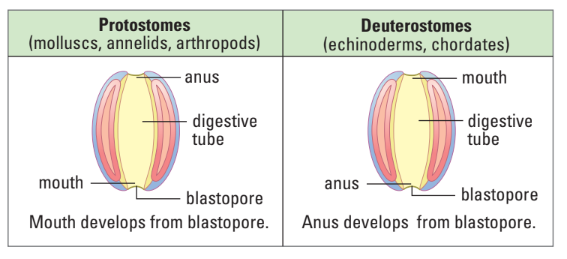
Symmetry
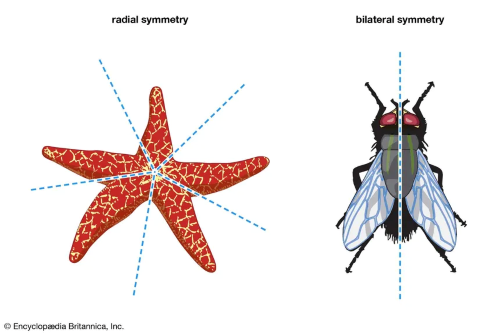
- asymmetrical: no symmetry in organism
- i.e. sponges
- radial symmetry: organism may be divided into multiple identical sections
- i.e. jellyfish, starfish
- bilateral symmetry: organism has mirror-image right and left sides
- organism has a true head region; concentration of nervous tissue in head
- well-adapted for movement (streamlined to move quickly)
- cephalization: development of distinct head w/ sense organs
- i.e. fish, mammals, squirrels
Segmentation and Limbs
- segment: repeating parts in animals
- in many bilaterally symmetrical animals
- annelid: segmented worms
- i.e. earthworms
- diff. sections like head, thorax, and abdomen of insects can also be specialized for specific functions
- paired limbs: external paired body part that extends from main body
- in many animals w/ bilateral symmetry and cephalization
- uses: movement, defence, sensory
- examples
- antennae
- mouthparts
- wings
- gills
- legs
- fins
- arms
- certain parts of tail
Phylogenic Tree of Animals
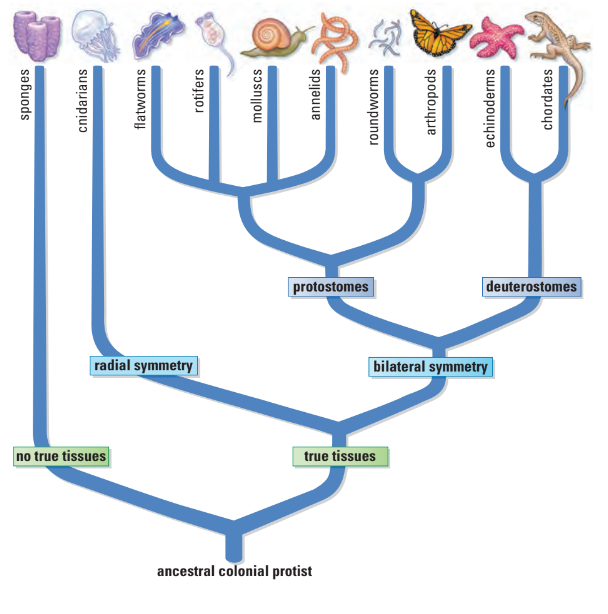
Invertebrates
Porifera
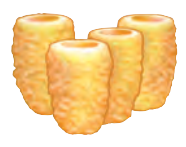
- support: protein (spongin) or mineral-based needle-like structures
- movement: adults are sessile (anchored in place)
- nervous: none
- reproduction: asexual (budding), sexual (male and female in same individual), zygotes develop into flagellated larvae
Cnidaria
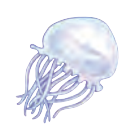
- support: fluid in gastrovascular cavity gives body shape
- movement: contraction of fibers arranged in microfilaments
- nervous: nerve net
- reproduction: asexual (budding), sexual (male and female in same individual)
Platyhelminthes
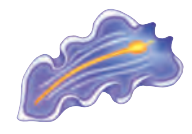
- support: true muscle tissue running along body
- movement: uses longitudinal muscles
- nervous: primitive brainlike ganglia (nerve clusters) and ventral nerve cords
- reproduction: asexual (fragmentation and regeneration), sexual (male and female in same individual)
Nematoda
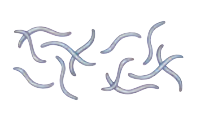
- support: exoskeleton called cuticle, must be shed to grow
- movement: all muscles are longitudinal, causes thrashing movements
- nervous: central brainlike ganglion, nerve cords to front and rear
- reproduction: sexual, most have separate males and females, mostly internal fertilization
Annelida
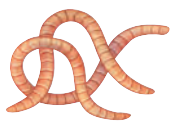
- support: fluid-filled compartments, muscles arranged circularly and longitudinally
- movement: body segmentation enables complex movement
- nervous: two ventral nerve cords connect to segmental ganglia, cerebral ganglia in head
- reproduction: sexual (male and female in same individual)
Mollusca
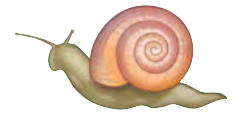
- support: mantle produces shell in most, muscular foot for movement
- movement: movement by muscular foot
- nervous: nerve ring around esophagus, with attached nerve cords
- reproduction: sexual, internal fertilization (external in polychaetes), most species have both sexes
Arthropoda
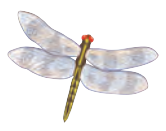
- support: protein and chitin exoskeleton, muscles attached to interior knobs
- movement: jointed appendages allow complex movements
- nervous: ventral nerve cord with several ganglia, two cords fuse into larger brain ganglion
- reproduction: sexual, separate sexes, internal fertilization
Echinodermata
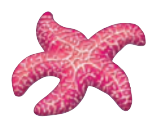
- support: endoskeleton of hard plates, water vascular system
- movement: water vascular system operates tube feet
- nervous: nerve ring with nerve cords along each arm
- reproduction: sexual, separate sexes, gametes released externally in water
Invertebrate Bodily Processes
Amoebocytes (Multi-purpose Cells)
- Digestion: These cells take in food, break it down, and move the nutrients around the sponge.
- Circulation: These multi-purpose cells handle the movement of substances.
- Excretion: These multi-purpose cells also deal with getting rid of waste.
- Gas Exchange: Gases move in and out at the cell level, mainly by spreading out (diffusion).
Animals with a Simple Gut (Gastrovascular Cavity)
- Digestion: Food is processed in a simple pouch with one opening that acts as both mouth and anus. Nutrients spread to the cells lining this pouch.
- Circulation: In flatworms, this simple gut is branched, helping to spread nutrients.
- Excretion: Most waste moves from cells into the surrounding water. Cells with tiny hairs (cilia) push fluid containing waste out through branched tubes.
- Gas Exchange: There are no special breathing parts. Gases move across cell membranes, helped by the movement of fluids within the simple gut.
Animals with a Body Cavity (General)
- Circulation: There’s no dedicated system for moving blood. Nutrients are carried by the fluid within the body cavity.
- Excretion: A special gland or tube connected to an opening helps maintain water balance and remove some waste.
- Gas Exchange: Gases move across cell membranes.
Animals with a Complete Gut (Tube with Mouth and Anus)
- Digestion: Food goes through a full tube with a mouth at one end and an anus at the other, having specialized parts like a stomach and intestine for processing.
- Circulation:
- Closed system: Blood stays within vessels, pumped by a heart, and carries oxygen with hemoglobin.
- Open system (most species): A heart pumps fluid that flows freely within the body cavity.
- Excretion:
- Special tubes (metanephridia) filter and remove waste from the blood.
- Other specialized tubes (nephridia) also remove waste from the blood.
- Gas Exchange:
- Moist skin acts as a breathing surface; oxygen from the skin is moved by the blood system.
- In water, special structures called gills (in the mantle cavity) are used for breathing. This mantle cavity can also function as a lung on land.
Insects and Spiders
- Circulation: A heart pumps fluid (not true blood) that flows freely within the body.
- Excretion: Special tubes (Malpighian tubules) remove waste from the body fluid.
- Gas Exchange: Aquatic forms have feathery gills. Land forms breathe through a network of tubes (tracheal tubes) throughout the body, while spiders have specialized structures called book lungs.
Animals with a Simple Gut (Short Digestive Tract with Mouth and Anus)
- Circulation: Fluid in the body cavity moves nutrients around.
- Excretion: No special waste removal organs. Waste diffuses out from the body fluid and through a water-based internal system.
- Gas Exchange: A water-based internal system helps with gas exchange.
Vertebrates
- vertebrae: series of skeletal segments in a backbone
- sing. vertebra
- amniotes: animals that produce amniotic eggs or can reproduce on land
- incl. reptiles, birds, and mammals
- amniotic egg: waterproof egg w/ shell, which allows vertebrates to reproduce on land
Phylogenic Tree
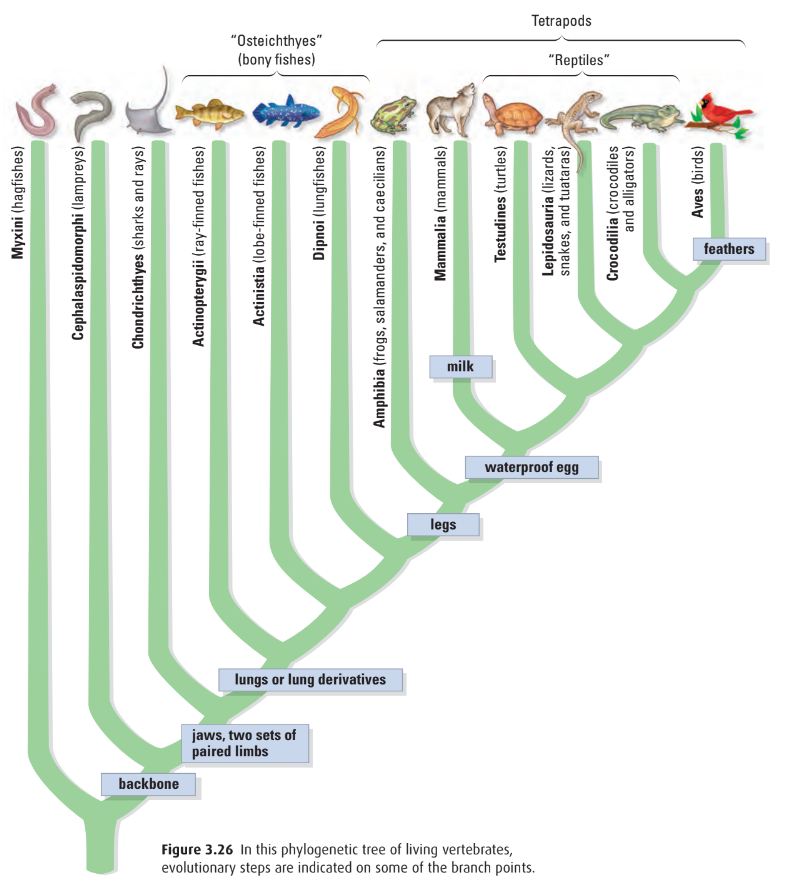
Project Notes
Refer to slides for better clarity on Canva
Project: Class Reptilia — Reptiles
Defining Characteristics
- vertebrate
- internal fertilization: fertilization of egg happens inside body
- scales cover part or all of the body
- reptiles known to shed their scales throughout their lifetime
- reptile scales contain beta-keratin
- typically cold-blooded
- change temp. by moving to warmer or colder environments
- if reptile lays eggs (most of them do), they lay soft-shelled eggs
- has lungs for breathing, no gills
- adapted to terrestrial environment
- reptiles produce amniotic eggs
- amniotic eggs: eggs w/ a special membrane and a shell to prevent embryo dehydration
- allows reptiles to lay eggs on land
Evolutionary Origins
- Oldest known common ancestor to both reptiles and amphibians: Casineria
- reptiles said to derive from a common ancestor during the Middle Pennsylvanian Epoch (~312-307 mya)
- earliest undisputed reptile: Hylonomous and Paleothyris
- sister group to reptiles taxonomically: Synapsida (mammal-like reptiles)
- for mil. of yrs., reptiles and synapsids were similar
- but over time, their lifestyles diverged and mammals arose from synapsids
- huge diversification of reptiles during the golden age of the dinosaurs, or the Mesozoic Era (biped dinosaurs were a thing)
- “Age of Reptiles,” the Mesozoic Era (251-65.5 mya)
- The earliest snakes evolved during the Middle Jurassic Epoch (174.1-163.5 mya)
Example: Massassauga Rattlesnake
Scientific name: Sistrurus catenatus
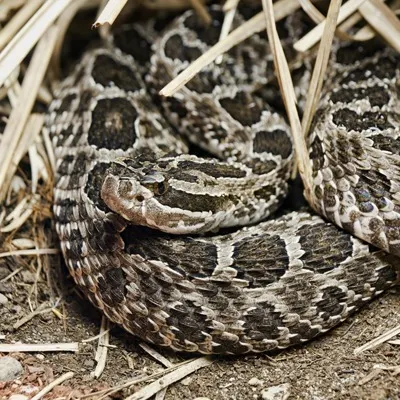
- Ontario’s only venomous snake
- Length: 47.2- 47.6 cm
- Grey to brownish grey with darker blotches along back and several rows of alternating blotches along sides; blotches edged in white
- Pit on each side of head between eye and nostril for heat sensing
- Distinct segmented rattle
- Tail thick, squarish; does not taper to a point like all others
- Does not always rattle a warning; relies on pattern and remaining motionless to go undetected
- Heavy-bodied; often found coiled
- Belly black
- Lives in different types of habitats including tall grass prairie, bogs, marshes, shorelines, forests and alvars
- Cold-blooded (ectothermic); require open areas to warm themselves in the sun
- Skin covered with scales; Dry smooth texture; keeled (ridged down the center) giving it a rough appearance
- Move by muscular contraction with the help of elongated scales on their abdomen
- Vestigial left lung, one functional lung
- No limbs, external ears, or eyelids
Example: Snapping Turtle
Scientific name: Chelydra serpentina
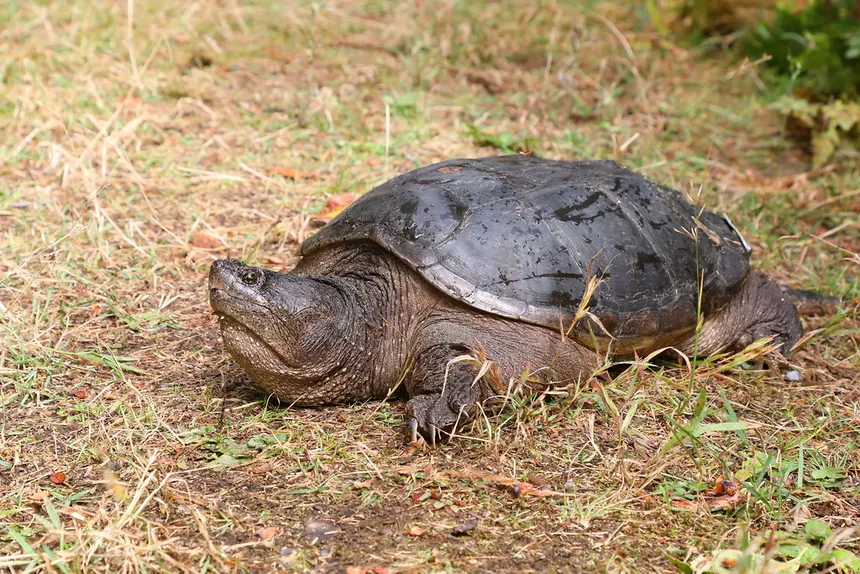
Physiology
- Largest freshwater turtle in Canada
- Average shell length: male: 36 - 43 cm / female: 28 - 37 cm
- Mass, male: 10 - 20 kg / female: 5 - 9 kg
- Appearance: Large, prehistoric-looking
- Shell relatively flat and brown during adulthood
- Shell color: black, olive, or brown (often covered in algae/moss)
- Skin colour: grey, brown, black / underside: white, cream, tan
- Triangular spikes along tail
- Prominent shell ridges
- Long neck and large head
- Webbed feet with long claws
- Sex determined by incubation temp. of embryos during a specific time of development
- Males produced at 23 - 28 C
- Females develop at cooler or warmer temps.
- They can see wider ranges of colors than humans
- Tetrachromacy color vision: E.g. they can see multiple shades of red
Habitat & Behaviour
- Native to southern Canada from eastern Saskatchewan to Nova Scotia, also found in eastern U.S.
- Active from April to Sept.
- Spend most of life in shallow waters (hide in mud and leaf litter, breathe with nose exposed)
- Not strong swimmers
- Usually walk on bottoms of ponds and rivers
- Nesting Season: Early to mid-summer
- Females travel overland to find nesting sites
- Frequently use man-made structures:
- Gravel road shoulders
- Dams
- Aggregate pits
Cool Facts
- Algae often grows on shell, helping with camouflage
- Cannot retract fully into shell; instead, they snap at threats
- Poorly known in wild
- Some over 100 years (based on Algonquin Park data)
- Take 15–20 years to reach maturity → adult deaths severely impact population
- High risk of being hit by vehicles
- Eggs near urban/agricultural areas often eaten by predators
Project: Class Amphibia — Amphibians
Defining Characteristics
- can exploit both terrestrial and aquatic environments
- name derived from Greek word amphibios, meaning “living a double life”
- typically has moist skin
- typically rely heavily on respiration (breathing) through the skin
- known to possess a double-channeled hearing system
- green rods in retinas to discriminate hues and two-part teeth
- eggs typically laid in water, young larvae develop in aquatic environment before moving out of environment
Evolutionary Origins
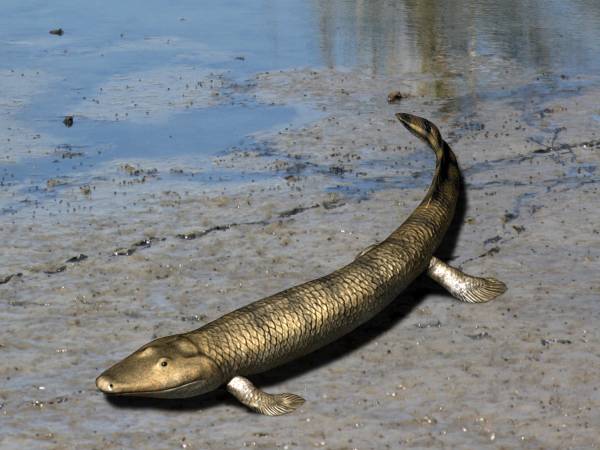
Tiktaalik
- first appeared ~340 mya during the Middle Mississippian Epoch
- the earliest groups to diverge from ancestral fish-tetrapod (fish w/ 4 feet) organisms, like the Tiktaalik
- Early tetrapods developed joints, stronger skeletons, and a flexible neck to support land movement
- transition from fins to limbs took over 80 million years, beginning in the Devonian Period
- Tiktaalik: intermediate form between fishes having fins and terrestrial animals having legs
- fossil evidence shows that amphibians arose from a lobe-fished lung ancestor ~365 mya
- amphibians were dominant land vertebrates for over 100 my, known as the “Age of the Amphibians”
- Frogs and salamander-like species appeared in the Triassic and Jurassic periods, with modern families emerging in the Cenozoic Era
- arrived during evolution of animals from aquatic environs. toward terrestrial environs.
Example: Golden Poison Dart Frog
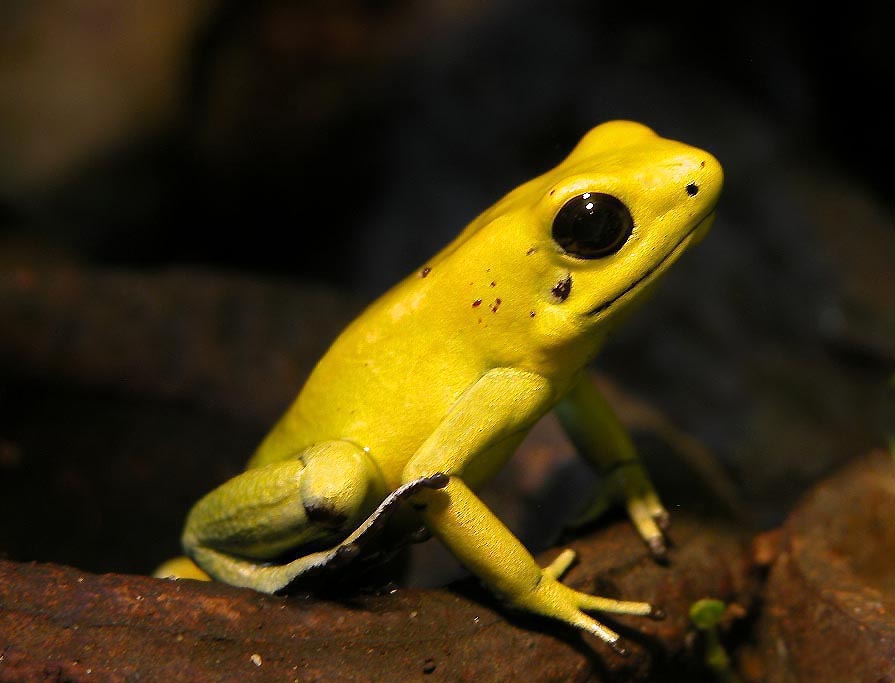
Scientific name: Phyllobates terribilis
- Considered one of the most toxic animals on Earth
- Size: 4.7 - 5.5 cm, Mass: 30 g
- Protruding eyes, No tail and claws
- Named terribilis to warn about its terrible poison
- Habitat: Tiny plot in Chocó rainforest on Pacific Coast of Columbia
- Has enough poison to kill 20,000 mice
- Smooth, moist skins, colour: yellow, orange, pale green
- Lives up to 10 years
- Large eyes compared to body size
- Short vertebral columns
- Gets poison from poisonous food, insects and plants
- Cutaneous respiration (through skin)
- Males dance to attract females, attracted females fight each other to get male, female rubs snout and back of frog before they mate
- Eggs laid on forest floor, male carries hatched tadpoles into a water source
- Diet controls insect populations and prevents overconsumption of plants